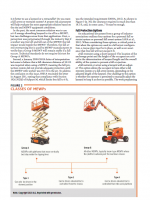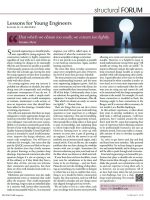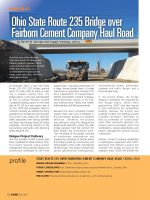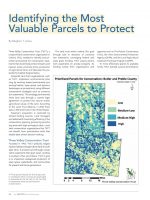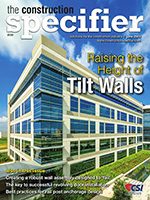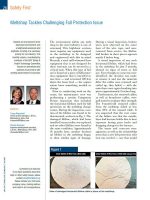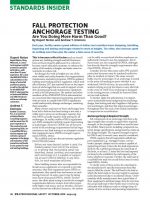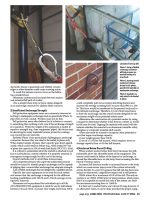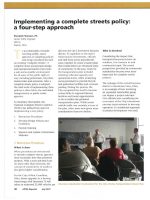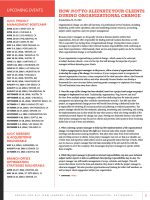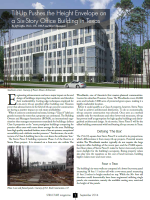Insights + Articles
LJB thought leaders are eager to share their insights in their various areas of expertise. Here you can find the latest articles and white papers published by LJB experts. Click the thumbnail or headline to access these valuable articles, presentations and resources.
The American workforce has a disproportionate work-at-height fatality rate due to excessive reliance on ineffective control methods. In this article, published in Professional Safety Journal and co-authored by LJB’s Thom Kramer, the authors outline the need for safety professionals to influence a paradigm shift, especially among those who only associate working at heights with the use of harness-based methods.
Published in Professional Safety Journal and co-authored by LJB’s Thom Kramer, this article shares how planning and a proper risk assessment can help organizations evaluate the best fall prevention and protection methods based on site and MEWP equipment conditions.
This article, published in Occupational Health and Safety Magazine, discusses the ways organizations can take advantage of technology to manage aspects of fall protection programs. By adopting practices that utilize technology-based tools and applications, organizations can reduce the inherent risk of identifying fall hazards and effectively manage and store data digitally. This article highlights tangible case studies from real applications and discusses the limitations organizations need to know when making decisions.
This article, published in Scaffold & Access Magazine, compares U.S. fall safety performance with that of other nations and further considers Prevention by Design, the Hierarchy of Control, and active and passive means of preventing falls. The article shows that by embracing successful tactics from around the world, hundreds of workers in the U.S. could be saved from fatalities every year.
To keep structural engineering attractive to the next generation and respected by society, we should let others know why our jobs are worthwhile. Instead of consistently highlighting our concerns, we should be letting college students, young engineers, and our communities know how our careers bring satisfaction and meaning to our lives.
Structural engineering is a stressful profession, especially for young engineers. The construction industry is highly competitive regardless of your niche in it, and clients are always looking for designs to be maximally efficient and executed as quickly as possible. Unfortunately, projects run even faster today than they did a decade ago, leaving less time for young engineers to learn how to produce quality work quickly and communicate effectively with their clients.
When a cement company needed to connect its existing quarry with a new quarry on the other side of a state route, LJB designed a bridge to create a new haul road that will extend the company’s mining operations for at least the next 30 years. The project also keeps large rock-hauling trucks off public roadways, minimizing impacts on the surrounding community and improving safety along the state route.
Fall protection equipment is the most visible aspect of a fall protection program, and it can also be the most costly. Unfortunately, these investments can be poured down the drain if personal fall protection systems are not implemented correctly. In this article published in The Leader magazine, LJB’s Thomas Kramer, P.E., CSP, provides tips to protect your personnel as well as your investment in fall protection PPE.
Three Valley Conservation Trust, a nonprofit land conservation organization in Oxford, Ohio, needed to identify and prioritize land parcels for conservation easements that would help protect streams and riparian zones, promote prime production of agricultural land, and decrease the potential for habitat fragmentation. LJB’s Meghan T. Jones developed a GIS model to enable them, as well as other organizations, to do just that.
In this article in the Construction Specifier magazine, LJB’s David Tomasula, P.E., and Jeff Griffin, PhD, P.E., PMP, joined Powers Brown Architecture’s Jeffrey Brown, FAIA, to explain why tilt wall construction has never had more potential to respond to real estate market challenges and to capitalize on several technological advancements.
When a steel mill crew’s fall protection system inspection revealed damage to lifelines in its meltshop, the mill tapped LJB to help overhaul the system. In this article published in Iron & Steel Technology magazine, discover the keys to creating the customized fall protection system that not only protects workers, but also withstands the extreme meltshop environment.
Each year, facility owners spend millions of dollars and countless hours designing, installing, inspecting and testing anchorages related to work at heights. Turns out, the time and money spent load testing anchorages may be doing more harm than good—damaging equipment and distracting from other potentially higher risk issues. In this article published in Professional Safety magazine, LJB’s Rupert Noton, CEng, MIStructE, and Martin/Martin Consulting Engineers’ Andrew T. Emmons, P.E., provide critical information on anchorage testing, enabling you to improve the safety of workers at heights and to make smart investments to reduce risk.
Fall protection equipment is the most visible aspect of a fall protection program, and it can be the most costly as well. Unfortunately, these investments can be nullified due to equipment misuse or “cheating”—using the equipment outside its intended use. The article explains the misuses and recommendations for how to rectify the misuses.
To accommodate a broader traveling public, many agencies are adopting policies and design standards focused on creating “complete streets.” This article outlines the four-step approach that the National Complete Streets Coalition has defined for implementing a new policy, as well as real-world examples of how it has worked for communities.
Because project managers are frequently viewed as business leaders within their organizations, they are often responsible for leading internal business functions as well. If your organization is approaching a period of change, here are five tips that will leverage the expertise of project managers without alienating your clients.
Engineering advancements can have a major impact on the end design of buildings, improving their aesthetics and therefore their marketability. This article highlights some cutting edge techniques employed for a six-story tilt-up speculative office building. This case study illustrates how advancements in the field of tilt-up concrete construction are having a positive impact on real estate profitability.

